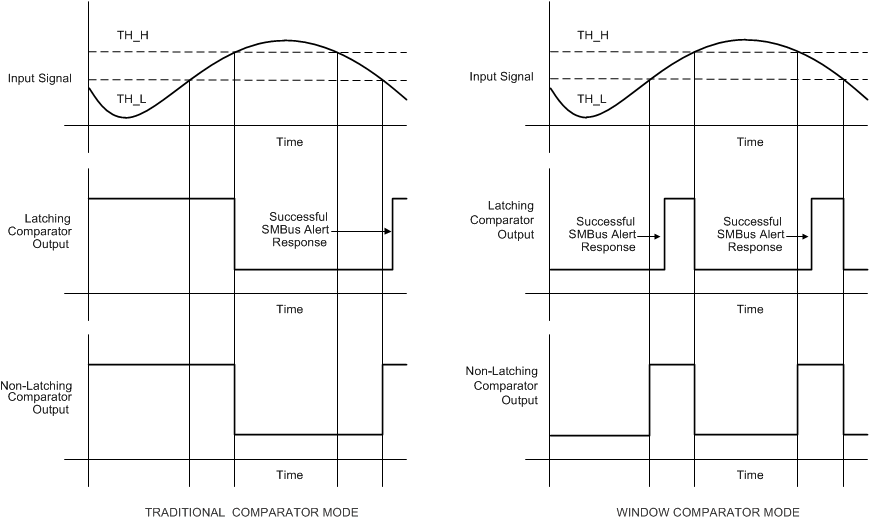JAJSQJ6 December 2023 ADS1114L , ADS1115L
PRODUCTION DATA
- 1
- 1 特長
- 2 アプリケーション
- 3 概要
- 4 Device Comparison Table
- 5 Pin Configuration and Functions
- 6 Specifications
- 7 Parameter Measurement Information
- 8 Detailed Description
- 9 Register Map
- 10Application and Implementation
- 11Device and Documentation Support
- 12Revision History
- 13Mechanical, Packaging, and Orderable Information
8.3.7 Digital Comparator
The ADS111xL features a programmable digital comparator that can issue an alert on the ALERT/RDY pin. The COMP_MODE bit in the Configuration register configures the comparator as either a traditional comparator or a window comparator. In traditional comparator mode, the ALERT/RDY pin asserts (active low by default) when conversion data exceed the limit set in the High-threshold register (Hi_thresh). The comparator then deasserts only when the conversion data falls below the limit set in the Low-threshold register (Lo_thresh). In window comparator mode, the ALERT/RDY pin asserts when the conversion data exceed the Hi_thresh register or fall below the Lo_thresh register value.
In either window or traditional comparator mode, the comparator can be configured to latch after being asserted by the COMP_LAT bit in the Configuration register. This setting causes the assertion to remain even if the input signal is not beyond the bounds of the threshold registers. This latched assertion can only be cleared by issuing an SMBus alert response or by reading the Conversion register. The ALERT/RDY pin can be configured as active high or active low by the COMP_POL bit in the Configuration register. Figure 8-6 shows operational diagrams for both comparator modes.
The comparator can also be configured to activate the ALERT/RDY pin only after a set number of successive readings exceed the threshold values set in the threshold registers (Hi_thresh and Lo_thresh). The COMP_QUE[1:0] bits in the Configuration register configure the comparator to wait for one, two, or four readings beyond the threshold before activating the ALERT/RDY pin. The COMP_QUE[1:0] bits can also disable the comparator function and put the ALERT/RDY pin into a high state.
 Figure 8-6 ALERT Pin
Timing Diagram
Figure 8-6 ALERT Pin
Timing Diagram